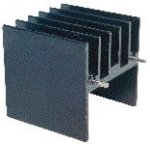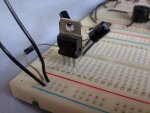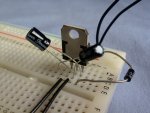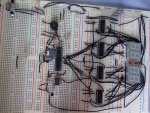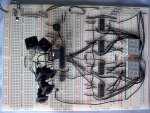Blue Eagle
Member
Before you ask, no, that was not the intention.
Basically i couldnt get the dual layer PCB routed correctly for this digital clock idea, so i resorted to the rather less elegant solution of building it on breadboard.
So anyway, yesterday i turn it on, the 7805 voltage regulator get's very hot, very quickly and gives off a small trail of smoke, so i unplug everything asap and have a look over the board for shorts and anything obvious, nothing, except the possiblity that i may have connected ground of the supply, to the output pin, instead of ground.
So i turn it on again, and after a few seconds, bang! flash of orange, big sound and the whole chip splits open
Does anyone know what could cause such a big problem that quickly? neither of the two cap's around it were damaged, and i didnt put a new program on the picaxe so none of the led's were drawing current and i've seen these things heat up due to short circuits and be fine. The datasheet even describes them as 'virtually indestructible'
The breadboard is semi-neat so i could post pictures of it if that would help, i was just wondering if anyone had done the same and knew how it happened. I have another 7805 but dont really want to try it until i know roughly what happened. Also, i was using a 26v DC supply, rated for 1.5A, a little high but within spec for the Vreg. (And the spare Vreg functioned just fine on this supply, it's a new one that went wrong, so i assume that points to a wiring mistake)
Basically i couldnt get the dual layer PCB routed correctly for this digital clock idea, so i resorted to the rather less elegant solution of building it on breadboard.
So anyway, yesterday i turn it on, the 7805 voltage regulator get's very hot, very quickly and gives off a small trail of smoke, so i unplug everything asap and have a look over the board for shorts and anything obvious, nothing, except the possiblity that i may have connected ground of the supply, to the output pin, instead of ground.
So i turn it on again, and after a few seconds, bang! flash of orange, big sound and the whole chip splits open
Does anyone know what could cause such a big problem that quickly? neither of the two cap's around it were damaged, and i didnt put a new program on the picaxe so none of the led's were drawing current and i've seen these things heat up due to short circuits and be fine. The datasheet even describes them as 'virtually indestructible'
The breadboard is semi-neat so i could post pictures of it if that would help, i was just wondering if anyone had done the same and knew how it happened. I have another 7805 but dont really want to try it until i know roughly what happened. Also, i was using a 26v DC supply, rated for 1.5A, a little high but within spec for the Vreg. (And the spare Vreg functioned just fine on this supply, it's a new one that went wrong, so i assume that points to a wiring mistake)

